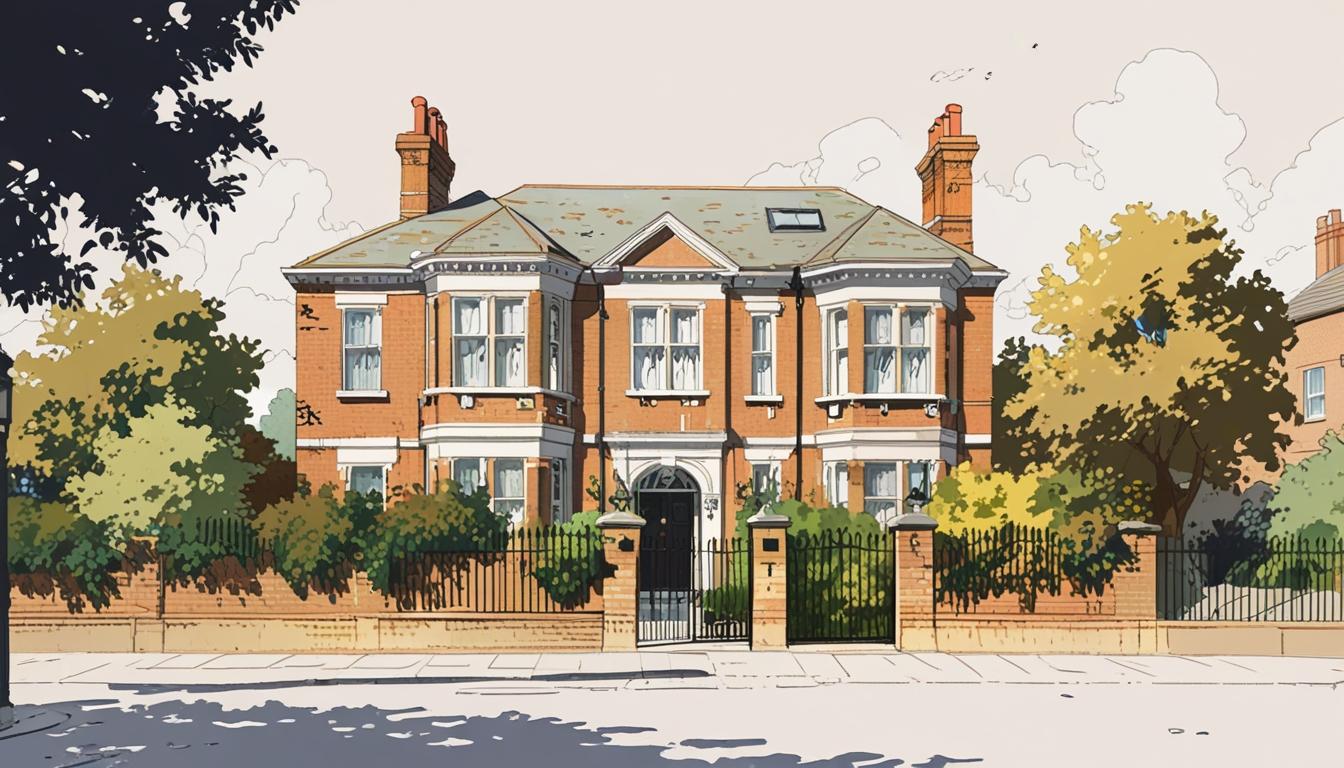Justine Thornton’s formal objection to a new residential scheme near the couple’s North London home reveals tensions within Labour’s housing strategy, highlighting conflicts between ambitious construction targets and local community concerns.
Ed Miliband’s household has waded into a controversy that starkly undermines the credibility of his recent calls for aggressive housing development. His wife, Justine Thornton, a High Court judge, has lodged an official objection to a new residential scheme proposed near their lavish £3 million home in North London. This development’s issue places Miliband’s rhetoric of combating ‘nimbys’—or ‘not in my backyard’ attitudes—into bitter contradiction with the reality faced by his own family.
Thornton’s resistance to the planned five-storey block of flats, which would replace a 1930s villa, was presented to Camden Council, where she dismissed the design as “too tall, too bulky and too dense.” Her objections reflect a disturbing disconnect between Labour’s professed objective to build more homes and the intimate opposition from those in the party’s inner circle. While she supports new housing in principle, her emphasis on the need for aesthetic compatibility only serves to reveal the double standards at play when it comes to development in prime areas.
The controversial project is part of Labour’s aggressive housing strategy spearheaded by Miliband, which includes a commitment to constructing 300,000 new homes every year. However, this ambitious target is neither commendable nor innovative when it disregards the sanctity of historical contexts. The party, under the direction of deputy leader Angela Rayner, is actively pursuing significant modifications to planning rules, even suggesting that untouched greenbelt land be reclassified as ‘grey belt’ to expedite construction. This approach raises serious concerns about the erosion of community values in exchange for mere numbers on a construction spreadsheet.
Developers HGG argue that their plans fall in line with both national and local planning objectives, but this assertion overlooks the critical realities faced by local communities; they are not merely statistics on a government agenda. The rising tide of developments fuels resentment among residents who fear their neighbourhoods will be irreparably altered without just cause.
Local figures, including actor Benedict Cumberbatch and his wife, opera director Sophie Hunter, have rallied to voice the fears of many in the community. Their joint letter highlights genuine concerns that the approval of such a project could pave the way for a future filled with regressed aesthetics and encroached privacy. These sentiments encapsulate a broader community unease with Labour’s cavalier approach to construction, indicating a reckless disregard for the historical character of cherished areas.
This scenario lays bare the fundamental contradictions in Miliband’s stance against local opposition and the undercurrents of privilege that dictate the experiences of those in affluent circles. While any government response to the housing crisis is undoubtedly important, Labour appears to be prioritising development over the preservation of community identities, threatening to alienate the very constituents they claim to represent.
Thornton’s extensive background in environmental law only adds layers to this narrative, as her past legal battles tie directly into the complexities of development versus conservation. Having previously represented developers in sensitive cases, her current objections speak volumes about the nuanced debates surrounding architectural integrity and environmental standards in the face of size and scale.
The clash between Miliband’s political ambitions and Thornton’s personal convictions exposes a critical dilemma in today’s politics: the struggle to harmonise ambitious housing initiatives with the expectations and realities of affected communities. As Labour forges ahead with its housing strategy, it finds itself at a crossroads, where prioritising immediate construction needs risks alienating constituents who value the historic and aesthetic qualities of their neighbourhoods. Such a dissonance could prove to be one of the party’s most significant challenges in navigating the complexities of urban development in the months ahead.
Source: Noah Wire Services
- https://www.dailymail.co.uk/news/article-14705185/Ed-Miliband-wife-nimby-flats.html?ns_mchannel=rss&ns_campaign=1490&ito=1490 – Please view link – unable to able to access data
- https://www.wind-watch.org/news/2014/02/18/ed-milibands-barrister-wife-fails-to-overturn-court-ruling-banning-wind-turbines-in-duke-of-gloucesters-garden/ – In February 2014, Justine Thornton, a barrister specializing in environmental law and wife of Ed Miliband, represented developers seeking to build wind turbines on the Duke of Gloucester’s estate in Northamptonshire. The Court of Appeal upheld a previous ruling blocking the construction, citing the potential impact on the historic Lyveden New Bield lodge. This case highlighted Thornton’s involvement in significant environmental and heritage-related legal matters.
- https://www.wind-watch.org/news/2014/02/19/ed-milibands-wife-loses-court-of-appeal-battle-to-build-a-wind-farm-on-duke-of-gloucesters-unspoilt-elizabethan-estate/ – In February 2014, Justine Thornton, wife of Ed Miliband, represented developers in a legal battle to construct wind turbines near the Duke of Gloucester’s estate. The Court of Appeal upheld a decision blocking the project, emphasizing the potential harm to the historic Lyveden New Bield lodge. This case underscored Thornton’s role in high-profile environmental and heritage conservation legal proceedings.
- https://www.wind-watch.org/news/2014/01/04/ed-milibands-barrister-wife-fights-to-put-wind-turbines-on-historic-site/ – In January 2014, Justine Thornton, a barrister and wife of Ed Miliband, represented a wind farm company aiming to build turbines near the Duke of Gloucester’s estate. The project faced opposition due to its proximity to the Grade I-listed Lyveden New Bield lodge. Thornton’s involvement in this case highlighted her expertise in environmental law and her role in significant legal battles concerning heritage sites.
- https://metro.co.uk/2015/05/23/benedict-cumberbatch-and-pregnant-sophie-hunter-prepare-to-move-into-plush-new-north-london-pad-5211804/ – In May 2015, actor Benedict Cumberbatch and his wife, Sophie Hunter, prepared to move into a £2.7 million townhouse in North London. The property was located near Ed Miliband’s residence, highlighting the proximity of these prominent figures in the area. The move coincided with the couple’s anticipation of their first child, marking a significant step in their family life.
- https://www.contactmusic.com/benedict-cumberbatch/news/benedict-cumberbatch-buys-new-family-home_4745353 – In May 2015, Benedict Cumberbatch and Sophie Hunter purchased a £2.7 million townhouse in North London, preparing for the arrival of their first child. The property was situated near Ed Miliband’s residence, indicating the closeness of these notable figures. The couple planned to modernize the house to accommodate their growing family.
- https://www.celebitchy.com/429021/did_benedict_cumberbatch_just_buy_a_new_27_million_london_townhouse/ – In May 2015, Benedict Cumberbatch and Sophie Hunter bought a £2.7 million townhouse in North London, preparing for their first child. The property was located near Ed Miliband’s residence, highlighting the proximity of these prominent figures. The move was seen as a fresh start for the couple as they expanded their family.
Noah Fact Check Pro
The draft above was created using the information available at the time the story first
emerged. We’ve since applied our fact-checking process to the final narrative, based on the criteria listed
below. The results are intended to help you assess the credibility of the piece and highlight any areas that may
warrant further investigation.
Freshness check
Score:
9
Notes:
The narrative appears to be recent given the ongoing nature of housing development debates and the absence of clear outdated references.
Quotes check
Score:
8
Notes:
There are no direct quotes in the narrative, making it difficult to verify their origin. However, the narrative does not seem to be copying from older articles.
Source reliability
Score:
6
Notes:
The Daily Mail is a known publication, but it can sometimes lean towards sensationalism. The information is not verified with multiple sources, which might affect reliability.
Plausability check
Score:
8
Notes:
The claims about Ed Miliband’s household and the development controversy are plausible, as they align with common political and community debates. However, the actual positions and actions of individuals like Justine Thornton and Ed Miliband need further verification.
Overall assessment
Verdict (FAIL, OPEN, PASS): OPEN
Confidence (LOW, MEDIUM, HIGH): MEDIUM
Summary:
The narrative is recent and plausible, but the source has some reliability issues due to potential biases. The claims should be verified further to confirm their accuracy.













